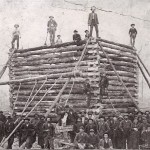“The raising of tobacco in Williamson County was vividly described to a representative of the Marion Daily Republican by Robert T. “Doc” Hampton who lives near the Herrin “Y”, between Herrin and Marion. The picture of the tobacco barn being erected on the E.N. Hampton home, which was located in the Crab Orchard Lake area, four miles south of Carterville and one half mile east was in a collection of pictures owned by Claude Cox, who operates a sawmill at the Herrin “Y”.
The picture was made around 1892 and yellow with age. Mr. and Mrs. Thomas Cox, parents of Claude Cox are shown in the picture. The only ones living today shown in the picture are Robert T. “Doc” Hampton, Mrs. Minnie Hampton Crowther of Carterville and Charles Moore of Carterville.
Hampton stated that all the neighbors came and helped build the tobacco bar. It was over 20 feet tall and held the total tobacco raised on ten acres of land. The women in the neighborhood came to the Hampton home and a big farm dinner was prepared for the men working on the barn. The trees were grown on the Hampton farm, hewn to the proper size and elevated to the barn by the use of ropes and saplings.
After the outside frame of the barn was erected, a door was sawn at the front. Hampton stated that his father hired Eli Thomas of Kentucky to come and fire his tobacco for him. A trench about three feet deep was dug in the bottom of the barn and this was filled with hickory wood and the tobacco was cured by a slow fire.
In the event the tobacco caught fire, it usually caught at the top of the barn, and the fire was put out by throwing buckets of water on the fire in the trench. The clouds of smoke and steam would go to the top of the barn and put out the fire.
While the tobacco was being cured it was necessary to keep a 24 hour watch on the fire to keep from burning or scorching the tobacco. When the tobacco was picked in the fields it was bound into hands, or bundles, each hand weighing about two or three pounds. After the tobacco was cured, the hands were removed from the curing racks, the stems were removed and it was twisted and put in boxes.
Hampton stated that this was one of the first large tobacco barns built in Williamson County. His father sold most of his tobacco to people who lived in Southern Illinois and did not raise tobacco. They could come on horseback and get the cured tobacco.
Hampton remembers that when he was a boy his father paid children ten cents a hundred to catch tobacco worms. The youths would go down the tobacco rows with a tin can hung around their necks and would remove the large green worms from the tobacco leaves. When they had their cans full of worms they would take them to Mr. Hampton, who would count the insects and the children would be paid.”
(Original article appearing in the Marion Daily Republican, March/24/1955; Photo courtesy of the Williamson County Historical Society)

